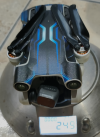Just wondering what are the reasons for needing ND filters on drones for video?
Unless you’re recording something that needs motion blur?
Thanks
Unless you’re recording something that needs motion blur?
Thanks
Last edited:
Since the very early days of cinematography there has been something called the 180 degree rule. On the first film cameras the rotating shutter was open for 180 degrees then closed for 180 degrees, exposing the film frame then moving to the next frame of film and repeat. That became the aesthetic of film at 24 fps with that amount of motion blur in the image. That rule is still followed today in feature films and television. If you want to work professionally with your drone you need to understand this. The other night I was shooting for a network television broadcast of a football game at a stadium. I was matching up to other stadium cameras so I was outputting 60i or 59.94 fps on my cendence controller to the mobile from an DJI Inspire 2. My shutter speed was 1/60th. If I was shooting at 24 fps gathering stock footage for production my shutter speed should be 1/48th on a broadcast camera but 1/50th is very close and acceptable on a drone. If you shoot without ND at a high shutter speed the footage looks very electronic and lacks natural motion blur and would not be acceptable for acquisition by a production house or broadcaster.Just wondering what are the reasons for needing ND filters on drones for video?
Unless you’re recording something that needs motion blur?
Thanks
Unfortunately, I see this a lot, especially when someone pans. You are correct though if shooting from high up with no side to side movement, it won't be noticeable. There are some videos that are unwatchable because they're panning or strafing with too high a shutter speed for the frame rate, especially on a large high refresh rate monitor.The stutter that folks worry about in practice rarely occurs. It requires high speed movement where there is a lot of change between each frame. Most flights do not meet this condition.
That is right in terms of matching. I’m only shooting with a mini 3 pro atm, and mainly scenery at that. If I was filming a moving object with a Mavic and its telephoto lens perhaps then I can see the need for motion blur and ND filters to achieve this. BTW I’ve never understood the 24fps thing…Since the very early days of cinematography there has been something called the 180 degree rule. On the first film cameras the rotating shutter was open for 180 degrees then closed for 180 degrees, exposing the film frame then moving to the next frame of film and repeat. That became the aesthetic of film at 24 fps with that amount of motion blur in the image. That rule is still followed today in feature films and television. If you want to work professionally with your drone you need to understand this. The other night I was shooting for a network television broadcast of a football game at a stadium. I was matching up to other stadium cameras so I was outputting 60i or 59.94 fps on my cendence controller to the mobile from an DJI Inspire 2. My shutter speed was 1/60th. If I was shooting at 24 fps gathering stock footage for production my shutter speed should be 1/48th on a broadcast camera but 1/50th is very close and acceptable on a drone. If you shoot without ND at a high shutter speed the footage looks very electronic and lacks natural motion blur and would not be acceptable for acquisition by a production house or broadcaster.
With the mini 3, wouldn’t an ND put it over 250g?

No. To install the ND filter on a Mini 3 or Mini 3 Pro, you have to remove a piece from the front of the camera, it's like a frame or guard, except it has no lens protection. On mine, it looks even bigger and heavier than the ND filter, so you are still under 250g.With the mini 3, wouldn’t an ND put it over 250g?
I agree with you. As I don't have an Inspire, I don't make films, and I don't film people and don't skim on the water (not to crash drone) I stay in the air and slowly to smooth, finally I don't use it any more. I've tried it like everyone and now I leave an ND4 on the Mini 3 Pro to protect the lens and change the sun's rays a little bit.I bought a set of ND filters for my Mini 3 Pro but I have yet to need them. I shoot mainly landscapes where motion in the frames is described better as "stately" rather than "frenetic".
Your ND4 filter doesn't "change the sun's rays a little bit".and now I leave an ND4 on the Mini 3 Pro to protect the lens and change the sun's rays a little bit.
I wonder if there's been anywhere in the entire world where there was a violation for 1 gm of discrepancyWith the mini 3, wouldn’t an ND put it over 250g?
what do you mean by that? How can one change the shutter angle?
Like someone will tell you to land so they can weigh it ?With the mini 3, wouldn’t an ND put it over 250g?


